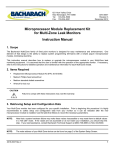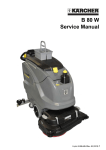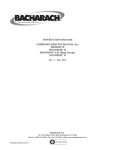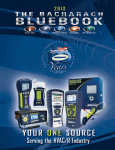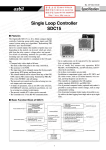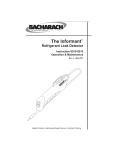Download Bacharach H-10PA Operating instructions
Transcript
H-10PA Refrigerant LeakDetector Congratulations! You have just purchased the most versatile, high performance service leak detector available in the industry today. This product has all the capability of the proven H10PM model except it does not contain the rechargeable battery and charger. The H10PA is powered by an external mobile 12 VDC battery using the included battery clamp and/or cigarette lighter power cable. This provides for ongoing testing without the need for frequent overnight recharge as is required with the H10PM. It will detect refrigerants with a sensitivity to effectively pinpoint both small and large leaks quickly and efficiently. We encourage your review of this manual to assure satisfactory performance and a long service life. For technical support call: 1-800-736-4666 How the H10PA Works The sensor in the H10PA uses a positive ion emission technology, commonly known as the heated diode. It is very sensitive to only halon substances (refrigerants) making this product highly resistive to false alarming, while retaining superior sensitivity for pinpointing the most difficult to find refrigerant leaks. A pump inside the unit draws air through the sensor. Any presence of halogen gases (such as refrigerants) causes an ionized current to flow that sounds a speaker and illuminates a neon light in the probe. Sensitivity to pinpoint both large and small leaks can be controlled by adjusting a three-position switch. Panel Operating Controls Before you use the unit for the first time: Sensor Heat Adjustment (turn clockwise to increase heat) Power Plug Sensor Power Switch Calibration Reference Bottle Mode Switch Sensitivity Switch Sensor “Set” Indicators Remove the sticky-label disc from the cap of the CALIBRATION REFERENCE bottle. This disc can be reused to help seal the vial when the leak detector is not in use or it can be discarded. DO NOT attempt to unscrew the cap; you may damage the bottle! It is filled with enough refrigerant to last approximately six months. 2 Operating Instructions 1. Using the included cables, connect to the 12VDC Battery and plug cable into the unit. 2. Slide LEAK SIZE switch to its SM (small) position. 3. Slide POWER switch to its ON position. 4. Check for sufficient airflow by pointing the probe tip toward the floor and observing the red airflow ball in the probe tip. It should be floating inside the probe tip. 5. Allow two minutes for the sensor to warm up; the flashing probe light and sound indicator will idle at 2–3 clicks per second. 6. Test operation by quickly touching the top of the CALIBRATION REFERENCE bottle (make sure sticky label is removed). The unit should respond with a rapid flash rate and sound verifying correct operation and optimum sensitivity for detecting all refrigerant leaks. During product life, if unit does not respond correctly, see Section Sensor Heater Adjustment. Setting the Sensitivity Small (SM) switch position is the highest sensitivity. The unit will indicate 0.1 ounce or greater leak rates and is used for fluorine based gases like R134a and SF6. This position also assures highest repeatability for locating 0.5 ounce or greater R134a leaks (per SAE Std. J1627 moving probe test conditions). It must always be used to verify performance and calibration when using the CALIBRATION REFERENCE bottle. 3 Medium (MED) position sensitivity is used for chlorine and chlorine based gases like R12, R22, R123, etc. and will indicate a 0.1 ounce per year or greater leak rate. This position supports finding a 0.5 ounce or greater leak during the moving probe test as defined in SAE J1627. It is also useful for locating larger R134a leaks of one ounce or greater. Large (LARGE) position is used to zero in on gross leaks of any refrigerant. If a large leak is suspected, set mode switch to MANUAL. Adjust BALANCE knob for a sound of 2–3 ticks per second and slowly approach the test equipment/area. Continue to turn the BALANCE knob counterclockwise as necessary to maintain 2–3 ticks per second. As you approach the vehicle or equipment, the gas concentration will increase, causing an alarm condition. Each time an alarm occurs, re-adjust the BALANCE control. Continue this process until the leak is located. Blowing out the test site with shop air may enable you to locate the leak more quickly. Note: After a large leak is located and repaired, blow out the area again with shop air, set the unit on the small leak sensitivity and double check equipment for small leaks. Warning! Personal Injury Hazard. Do not use the H10PA in an explosive or combustible atmosphere. The ambient atmosphere is drawn through the probe and through the sensor, which operates at approximately 1472°F (800°C). The resulting hot mixture of air and combustible gas could explode. 4 NOW… YOU’RE READY TO FIND THE LEAK! (You have a choice of two modes) Auto Mode This mode is preferred because the unit effectively auto zeros to block out background levels of refrigerants and changes in background contamination. This greatly reduces and/or eliminates false alarms while retaining sensitivity to quickly locate small or medium size leaks. Pinpointing leaks in this mode requires continuous probe movement. (We recommend 2 inches per second as specified in SAE J1627 and J1628). If the probe remains on the leak the unit will zero out the leak, going into the idle 2–3 ticks/second condition. Briefly moving the probe away from the leak for 1–2 seconds permits the fast auto recovery to re-establish sensitivity. Returning to the leak site, the unit will alarm again. The unit will reliably and repeatedly pinpoint the leak with each pass over the leak site. If a large gross leak is present, the auto zero circuit may reduce sensitivity to an unacceptable level to find small and medium sized leaks. If this condition exists, the manual mode will enable you to pinpoint the large leak. The manual mode is also an effective means to determine if a gross leak of any refrigerant exists prior to searching for leaks (see Section Setting the Sensitivity). Manual Mode In the Manual Mode the auto zero function is disabled, causing the unit not to zero out the leak if the probe is 5 held at the leak site. This mode may require frequent re-adjustment of the BALANCE control to maintain the required 2–3 ticks per second that indicates proper adjustment and calibration for all three sensitivity switch positions. In this mode you may notice sensitivity is slightly greater (10–20%) than the 100% auto zero mode. This is normal. Sensor Heater Adjustment The sensor’s HEATER ADJUSTMENT controls the sensitivity of the unit. A heat setting that is too high causes instability due to excessive sensitivity and shortens sensor life. The Low, OK, and High LED indicators in conjunction with the HEATER ADJUSTMENT and the CALIBRATION REFERENCE bottle, is a unique system for setting the correct sensor heat (sensitivity) for optimum calibrated performance and long sensor life. The unit is preset for optimum initial operation. To check the setting, slide the LEAK SIZE switch to its SM (small) position, turn ON the unit and allow it to stabilize (approximately 2 minutes). When stabilized, at 2–3 clicks per second, briefly touch the CALIBRATION REFERENCE bottle with the probe (after removing the sticky label disc from the top of the bottle). If adjusted properly, the red Low LED light will go out and the green OK LED will briefly light. This indicates the sensor heat/sensitivity is adjusted for optimum performance. If the red LED Low light remains on when you briefly touch the bottle, the HEATER ADJUSTMENT is set too low and must be turned slightly clockwise; afterwhich, allow the unit to stabilize about 6 one minute and retest. If necessary, continue to rotate the HEATER ADJUSTMENT clockwise and retest until the green OK LED briefly comes on. If during this test the red High LED comes on, the heat is set too high and the HEATER ADJUSTMENT should be turned slightly counterclockwise. Allow the unit to stabilize and then repeat the test. Continue this procedure until proper green OK LED operation has been achieved. NOTES: A. After initial check for correct adjustment, disregard Low, OK, High LED indication. Their indication is meaningless during subsequent leak testing activity. B. Check for proper heat adjustment the first time the unit is turned on and repeat on a daily basis. This assures the product is calibrated for the correct sensitivity in all leak size switch positions for your daily test activity. C. Frequency of sensor heat adjustment is a function of how much exposure the sensor has to refrigerant. Adjustment may be required every 2 weeks for heavy duty service and once every few months for light duty service. The sensor LED status indicators will accurately tell you when adjustment is necessary during the daily check. D. It is time to replace the sensor when the HEATER ADJUSTMENT is fully clockwise and the green OK LED will not come on. Before replacing the sensor, turn the HEATER ADJUSTMENT fully counterclockwise; plug in a new sensor; then test and adjust as previously described to correctly calibrate the instrument. 7 Application Notes 1. Conduct a leak check in a logical progression through the entire system to locate all leaks. If surfaces are particularly dirty, or wet, wipe them off with a clean, dry cloth to reduce filter clogging and extend sensor life. DO NOT allow the unit to ingest moisture. Use of the supplied rubber probe tip helps prevent moisture from being drawn into the unit. Check ports for moisture before inserting the probe. 2. After locating and repairing any leaks requiring the use of the LARGE setting, switch to the MEDIUM setting and verify the system is free of leaks. For HFC refrigerants only (such as R134a), you also must verify the system is leak free using the SMALL setting. For CFC and HCFC systems (such as R11, R12, R22, R123), the MEDIUM setting is sufficient to verify that the system is free of leaks that require repairing. Maintenance To protect the air pump from damage due to foreign particles and moisture, replace the filter as it becomes dirty. With moderate use (15 to 30 minutes a day), it is recommended that the filter be replaced once a month. In dirty environments or with heavy use, replace the filter more often. Always replace the filter when it is visibly dirty or wet. Replacing the Filter: 1. Remove the black rubber probe tip. 2. Pick out the filter with a pin or tweezers. A fine screen will remain in the tip of the probe. 3. Insert the new filter in the probe tip. 8 Caution: Equipment Damage Hazard. Submerging the probe in liquid will damage the vacuum pump. Exposing the probe to a stream of refrigerant coming out of a tank will severely reduce the life or destroy the sensor. The life of this unique rare earth sensor is directly proportional to the amount of refrigerant that passes through it. With normal intermittent service, the sensor can last for one year or longer. Exposure to high concentrations of refrigerant may require adjustment of sensor heat. To check, repeat the test procedure in the “Heater Adjustment” section. Make sure that the filter is firmly seated against the fine screen. 4. Replace the rubber probe tip. Replacing Airflow Ball Indicator: 1. Remove the clear plastic section of the probe tip by gently pulling and twisting the white grip. 2. Turn the probe tip upside-down and tap on it to remove the old airflow indicator ball. 3. Insert the new airflow indicator bal into the tip. Filter Probe Tip Airflow Indicator Ball Rubber Probe Tip 4. Reattach the probe tip to the probe assembly. 9 Replacing the Sensor: The sensor is a disposble plug-in unit. Replace it when the H10PA no longer responds to the CALIBRATION REFERENCE bottle, even with the sensor HEATER ADJUSTMENT turned fully clockwise (make sure the CALIBRATION REFERENCE bottle contains some refrigerant). 1. Set the POWER switch to OFF. 2. Unplug the power cord if the unit is plugged in and open the sensor cover. 3. Allow the sensor to cool before handling. Warning! Personal Injury Hazard. Sensor surface temperature may reach 390°F (200°C) during operation, and may cause a burn if not allowed to cool. 4. Unplug and discard the sensor. 5. Insert a new sensor and close the sensor cover. 6. Turn the sensor HEATER ADJUSTMENT to its full counterclockwise position. 7. Apply power to the unit and reset the HEATER ADJUSTMENT (see Section Sensor Heater Adjustment). 10 Troubleshooting Problem Cause Solution Responds to reference leak on LARGE setting. HEATER ADJUSTMENT set too high. Readjust heater (see section Sensor Heater Adjustment). **Solution number corresponds to Cause number** Problem Cause Solution No response to CALIBRATION REFERENCE bottle. 1HEATER ADJUSTMENT set too low or bottle is empty. 2No air flow (indicator ball in probe doesn’t float). 3Sensor exposed to excessive amounts of halogen gas. 4Water in probe. 1Readjust heater (see Sensor Heater Adjustment) or replace bottle (3015-0864). 2Replace filter in probe tip (3015-0784). Check pump operation. 3Move probe to clean atmosphere for several minutes while sensor purges itself. Test reference bottle for correct operation. 4Turn unit OFF and disconnect probe from the chassis. Remove screws and take out chassis. Look at the underside of the leak detector and follow the probe to the pump. Remove this hose from the pump. Blow clean air (5 psi) into the probe tip for one or two minutes. Reassemble unit and replace the filter 11 (3015-0864). Troubleshooting (continued) Problem Cause Solution Problem Cause Solution 12 Erratic response in all leak positions. 1Filter is clogged. 2Dirt in sensor. 3Short circuit in sensor. 4Atmosphere contaminated with excessive refrigerant gas. 1Replace filter (3015-0784). 2Remove sensor and blow it out with clean air (not over 10 psi). If unsuccessful, replace sensor (3015-0486). Replace filter (3015-0784). 3Replace sensor (3015-0486). 4Ventilate Area. Responds continuously only in small leak position. Excessive sensitivity. Readjust heater (see Sensor Heater Adjustment). Ordering Information H10PA Refrigerant Leak Detector with 12VDC Power Cord 3015-0326 14 inch Flexible Probe Extension 3015-0119 100-240VAC Charge/Run AC Adapter 3015-4161 Battery Clamp Adapter Cable 3015-0868 Cigarette Lighter Adapter Cable 3015-0641 Replacement Probe Tip 3015-0680 Replacement Rubber Probe Tip 3015-0781 Tune-up kit; (Sensor, 100 Filters, 3 Airflow Indicator Balls, 3 Rubber Probe Tips, and Leak Calibration Bottle 3015-0486 Replacement Sensor 3015-0784 Maintenance kit; (100 filters, 3 Airflow Indicator Balls, 3 Rubber Probe Tips, and Leak Calibration Bottle 3015-0864 Replacement Calibration Reference Bottle (contains 6 month supply of refrigerant) 13 Repair Information Should it become necessary to repair your H-10PA, please contact an authorized service center. Units should be carefully packed to prevent shipping damage and shipped prepaid. Warranty Send units under warranty and a copy of the purchase receipt to an authorized service center for repairs. Repairs will be completed and the unit(s) returned to you with the same priority of shipment that it was received. Please include your company name, telephone number including area code, and a contact name. Non-Warranty Units that are no longer under warranty will be repaired to factory specifications for a nominal fee. The unit will be returned to you with the same priority of shipment that it was received. Please include your company name, telephone number including area code, and a contact name. Limited Warranty The purchaser is warranted that this leak detector will be free of defects in material and workmanship for 5 years from date of purchase. This warranty does not cover sensors, reference leaks, filters, airflow balls, lamps, or probe tips. Damages caused by the user will not be covered. If any defects are discovered during the warranty period, an authorized service center will repair or replace the unit at their option. The foregoing limited warranty is exclusive and in lieu of all other warranties, whether written or implied, and no warranty of merchantability or fitness for purpose will apply. 14 Authorized Service Centers United States Bacharach, Inc. 621 Hunt Valley Circle New Kensington, PA 15068 Phone: 724-334-5000 Fax: 724-334-5001 E-mail: [email protected] Canada Bacharach of Canada, Inc. 20 Amber St. Unit #7 Markham, Ontario L3R SP4 Canada Phone: 905-470-8985 Fax: 905-470-8963 E-mail: [email protected] 15 SAE J1627 621 Hunt Valley Cirlce New Kensington, PA 15068 WEBSITE: http://www.mybacharach.com PH: 724-334-5000 FAX: 724-334-5001 3015-0952 REV. 3 – 11/2009

















